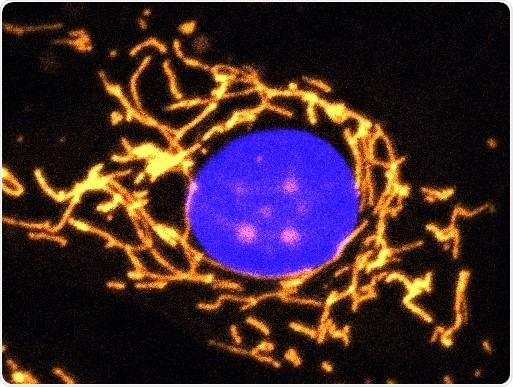Researchers from Trinity College Dublin have created a novel gene therapy approach that shows promise for someday treating an eye disease that results in progressive vision loss and affects an unlimited number of people around the world.

A fluorescent microscope image with mitochondria highlighted in gold. This healthy cell shows a highly elaborate and well-connected network of mitochondria. Image Credit: Professor Jane Farrar and Dr Daniel Maloney, Trinity College Dublin.
The research work, which involved an partnership with clinical groups in the Royal Victoria Eye and Ear Hospital and the Mater Hospital, also holds implications for a relatively broader range of age-related neurological disorders.
The researchers have recently published their findings in the renowned journal, Frontiers in Neuroscience, on November 26th, 2020.
Dominant optic atrophy
Dominant optic atrophy (DOA) is characterized by the degeneration of the optic nerves and generally begins to cause symptoms in people in their early adult years. DOA is associated with moderate vision loss and certain defects in color visions, but the level of severity differs, symptoms can worsen over time, and a few people may even lose their vision. At present, there is no method to cure or prevent DOA.
The OPA1gene gives instructions for forming a protein that is present in tissues and cells across the body, and which is crucial for regulating the proper function in mitochondria—the energy producers in cells.
In the absence of this protein made by the OPA1 gene, the function of the mitochondria becomes sub-optimal and the network of mitochondria, which in healthy cells is optimally interconnected, is extremely disrupted.
For patients living with the DOA disorder, the dysfunctional mitochondria, and mutations in the OPA1 gene contribute to the onset and progression of this medical condition.
The new gene therapy
Headed by Dr. Daniel Maloney and Professor Jane Farrar from the School of Genetics and Microbiology at Trinity College Dublin, the researchers have created a novel gene therapy, which effectively shielded the visual function of mice. These animals were treated with a chemical that targets the mitochondria and were consequently living with faulty mitochondria.
The researchers further discovered that their new gene therapy enhanced the performance of the mitochondria in human cells that contained mutations in the OPA1 gene, providing hope that it may be effective in individuals.
We used a clever lab technique that allows scientists to provide a specific gene to cells that need it using specially engineered non-harmful viruses. This allowed us to directly alter the functioning of the mitochondria in the cells we treated; boosting their ability to produce energy which in turn helps protects them from cell damage.”
Dr Daniel Maloney, Scientist and Research Fellow, School of Genetics and Microbiology, Trinity College Dublin
Dr Maloney continued, “Excitingly, our results demonstrate that this OPA1-based gene therapy can potentially provide benefit for diseases like DOA, which are due to OPA1 mutations, and also possibly for a wider array of diseases involving mitochondrial dysfunction.”
Most significantly, the dysfunction of the mitochondria leads to problems in a range of other neurological disorders, like Parkinson’s and Alzheimer’s disease. The effects slowly accumulate over time, which is why several patients may associate these disorders with aging.
We are very excited by the prospect of this new gene therapy strategy, although it is important to highlight that there is still a long journey to complete from a research and development perspective before this therapeutic approach may one day be available as a treatment.”
Jane Farrar, Research Professor, School of Genetics and Microbiology, Trinity College Dublin
Farrar continued, “OPA1 mutations are involved in DOA and so this OPA1-based therapeutic approach is relevant to DOA. However mitochondrial dysfunction is implicated in many neurological disorders that collectively affect millions of people worldwide.”
“We think there is great potential for this type of therapeutic strategy targeting mitochondrial dysfunction to provide benefit and thereby make a major societal impact. Having worked together with patients over many years who live with visual and neurological disorders it would be a privilege to play a role in a treatment that may one day help many,” Farrar concluded.
Source:
Journal reference:
Maloney, D. M., et al. (2020) Optimized OPA1 Isoforms 1 and 7 Provide Therapeutic Benefit in Models of Mitochondrial Dysfunction. Frontiers in Neuroscience. doi.org/10.3389/fnins.2020.571479.